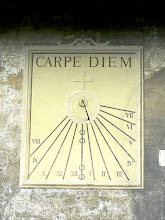SPRING EQUINOX, MARCH 20th, 2010

SPRING EQUINOX OFFERS A NIGHT SHOW
on Saturday, March 20th, 2010
__________________________________
When the sun sets on Saturday, March 20th, a special kind of night will fall across the Earth.
It's an equal night.
Or as an astronomer would say, "it's an equinox."
It's the date when the sun crosses the celestial equator heading north.
Spring begins in one hemisphere, Autumn in the other.
The day and night are of approximately equal length.
To celebrate the occasion, Nature is providing a sky show.
It begins as soon as the sky grows dark.
The Moon materializes first, a fat crescent hanging about a third of the way up the western sky.
Wait until the twilight blue fades completely black and you will see that the Moon is not alone. The Pleiades are there as well.
The Moon and the Pleiades are having a close encounter of rare beauty.
There's so little space between the two, the edge of the Moon will actually cover some of cluster's lesser stars.
This will be the best Moon-Pleiades meeting, until the year 2023.
The Pleiades are a cluster of young stars, some 440 light years from Earth.
They formed from a collapsing cloud of interstellar gas about 100 million years ago.
By the standards of astronomy, that's really young.
The Earth under your feet is almost 50 times older.
Dinosaurs were roaming our planet long before the Pleiades popped into being.
Only about seven of the Pleiades are visible to the unaided eye.
The "Seven Sisters" are:
Sterope, Merope, Electra, Maia, Taygete, Celaeno and Alcyone,
named after daughters of the mythological Greek god Atlas.
Together, they form the shape of a little dipper, which is why the Pleiades are often mistaken for the Little Dipper, an asterism of Ursa Minor.
Binoculars are highly recommended for this event.
First, scan the Moon.
You'll see craters, mountains and lava seas.
Note that you can see the entire Moon, not just the brightly-lit crescent.
The Moon's dark terrain is illumined by a ghostly glow called "Earthshine."
It is the light of our own blue planet shining down on the Moon.
Next, scan the sky around the Moon.
The Pleiades come into sharp focus....and they are more than seven.
Dozens of faint "sisters" can be seen through even modest optics.
This night doesn't sound equal. It sounds much better than that.
Experience the Equinox !!!
==============================
...


0 Comments:
Post a Comment
<< Home